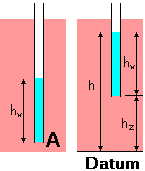Pressure, Elevation and Total Heads
In soils, the interconnected pores provide passage for water. A large number of such flow paths act together, and the average rate of flow is termed the coefficient of permeability, or just permeability. It is a measure of the ease that the soil provides to the flow of water through its pores.

At point A, the pore water pressure (u) can be measured from the height of water in a standpipe located at that point.
The height of the water column is the pressure head (hw).
hw = u/gw
To identify any difference in pore water pressure at different points, it is necessary to eliminate the effect of the points of measurement. With this in view, a datum is required from which locations are measured.
The elevation head (hz) of any point is its height above the datum line. The height of water level in the standpipe above the datum is the piezometric head (h).
h = hz + hw
Total head consists of three components: elevation head, pressure head, and velocity head. As seepage velocity in soils is normally low, velocity head is ignored, and total head becomes equal to the piezometric head. Due to the low seepage velocity and small size of pores, the flow of water in the pores is steady and laminar in most cases. Water flow takes place between two points in soil due to the difference in total heads.